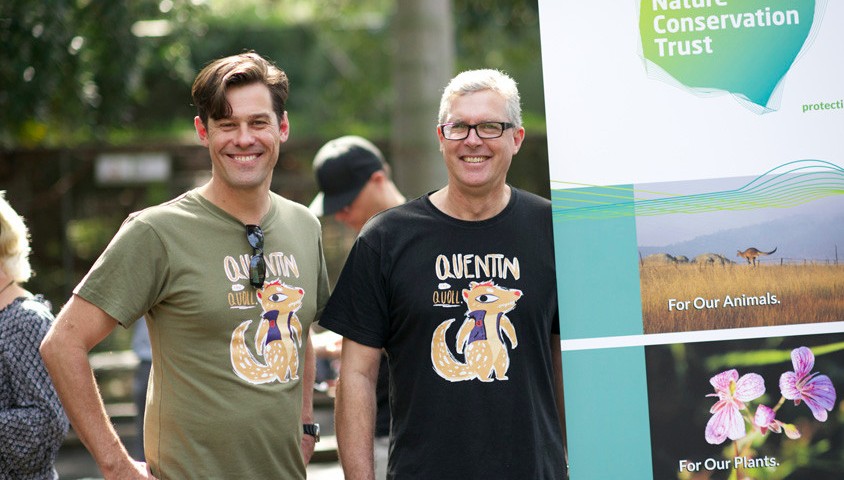A recent campaign centred around Quentin, a tiger quoll, is helping the Nature Conservation Trust (NCT) to stay on track to reach its goal of protecting 50,000 hectares of New South Wales bush by the end of this year.
The goal, a benchmark set in 2010, requires private landholders of high conservation value properties to freely enter into Trust Agreements that restrict certain types of activities from occurring on certain sites within the property.
So far, 91 Trust Agreements have been instated across NSW, which cover the majority of the 50,000 hectare benchmark.
Gary Wells, CEO for NCT said landholders enter into agreements out of altruistic motives – primarily from a sense of their duty of care to the environment – but there are some agreements that have incentive funding attached where relevant.
“Some Trust Agreements do come with some incentive funding attached to assist with fencing, weed or feral management but this is usually a relatively nominal amount,” Wells said. “Plus, there are some grant funding opportunities that are offered to landholders with Trust Agreements that enable them to undertake further enhancement work on their land.”
These agreements, which are legally binding and are backed by the Nature Conservation Trust Act of 2001, are lodged against the property title, but rarely apply to the entire property. They generally require the landholder to maintain or improve the condition of those areas identified in the agreement, with NCT surveying the land every five years to see how the sites are performing.
Conservation Value
NCT targets specific types of properties to be considered for a Trust Agreement, and judges them based on a variety of metrics in a bid to identify conservation value.
“These are areas that, under the Threatened Species Act, contain vegetation communities known as Endangered Ecological Communities,” Wells explained. “These are rare examples of natural systems that can include grasslands, woodlands, wetlands or forests that in what could be described as original condition, where there has been little or no clearing and little incursion from invasive weeds or feral animals.”
Other elements that assist in judging the lands include the connectivity of natural systems, such as whether it’s congruent with other reserves, as well as any significance relating to cultural heritage at the site.
“We do consider properties right across NSW, but generally focus on the woodland belt that runs off the western edge of the Great Dividing Range. This belt has been cleared by up to 95 per cent of its original range, which has had a devastating effect on the wildlife that rely on this landscape.”
Critical areas are considered for any available incentives and all funding is provided through fundraising or third party partnerships. In this way the NCT can continue to increase awareness of its projects, while providing on-the-ground support for landholders to actively improve the natural heritage quality of their land.
This concept is taken one step further by the NCT’s ‘revolving fund’, which is designed to be made available when ever sites of critical importance are placed on the market.
“This allows us to select and purchase ecologically significant properties that are for sale, apply a TA to the title, then onsell it in the open market,” Wells said. “Many of these properties are purchased by individuals who want to contribute to the protection of native species while undertaking sympathetic enterprises such as organic farming, eco-tourism and so on.”

Miriam Margolyes meets Quentin in a bid to spread awareness of the importance of conservation-focused Trust Agreements.
Quentin the Quoll
The NCT’s recent campaign involved a partnership between a tiger quoll and renowned English-Australian actor, Miriam Margolyes (perhaps best known for her role in the recent Harry Potter film franchise).
Margolyes also happens to own property in NSW in the Southern Highlands – a property on which she has now entered into a Trust Agreement.
“I was thrilled that the Nature Conservation Trust team was able to inspect my property and sort out the arrangements even though I was overseas at the time,” she said. “I hope other property owners will follow suit to assist us in protecting Australia’s magnificent species and their habitats.”
Margolyes made a recent appearance at Featherdale Wildlife Park to pose for photos with Quentin the tiger quoll, a species that the NCT hopes to assist through the Trust Agreements initiative.
“Our current campaign aims to increase the area of habitat protecting the tiger quoll which is the largest carnivorous marsupial on the Australian mainland. With 59 per cent of all native mammals in NSW now listed as threatened with extinction, it is important to do all we can to protect these animals, particularly on private land which accounts for about 80 per cent of the land in the state,” Wells said.
Other threatened or endangered species the NCT hopes to secure a future for includes the regent honeyeater, the crimson spider orchid and Anthrophyum austroqueenslandicum (a species thought extinct until it was recently rediscovered, conveniently, on an NCT property).



